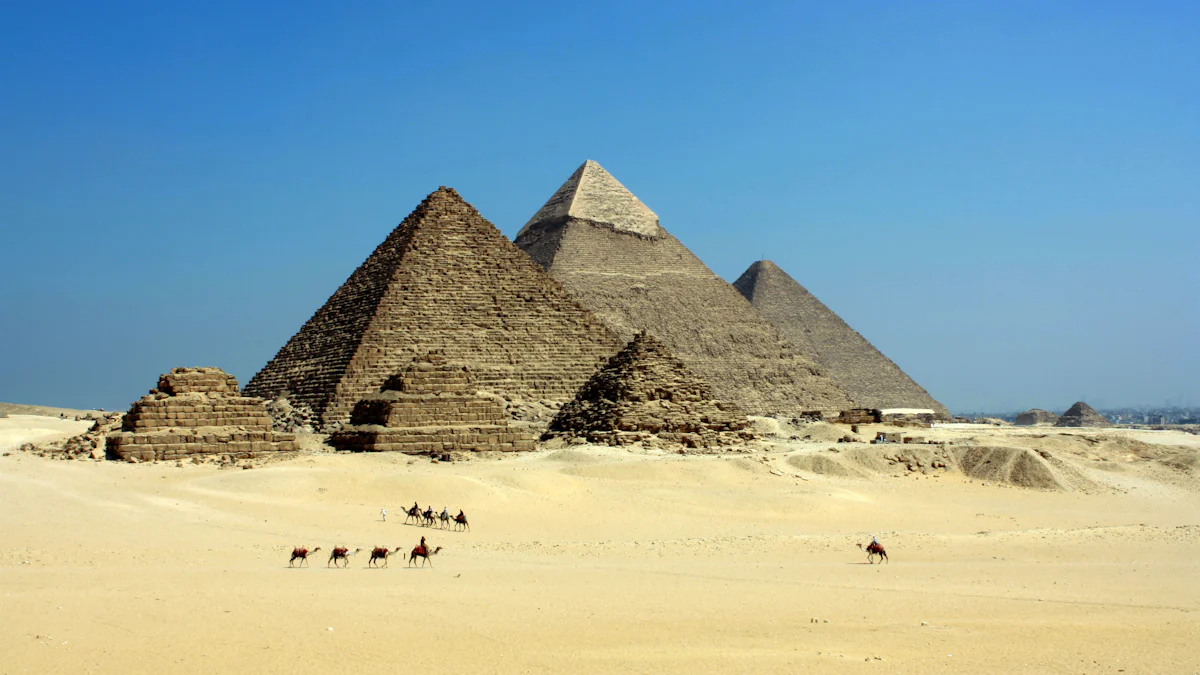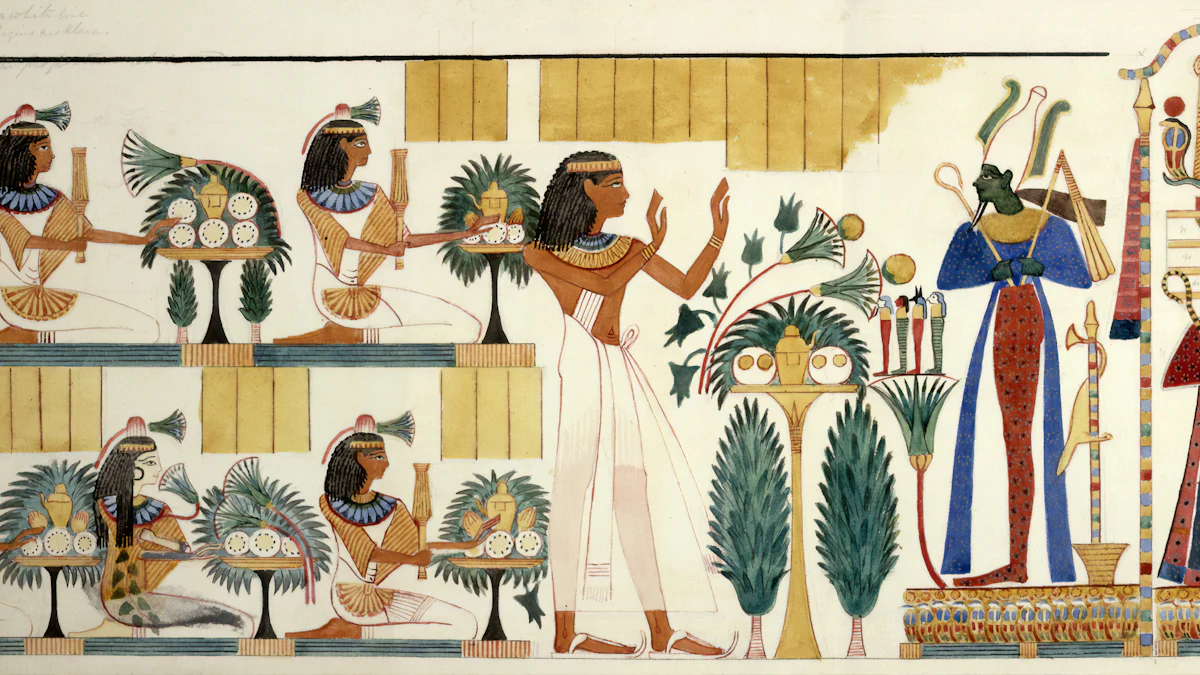Ancient Egypt: An Illustrated History

Ancient Egypt captivates with its rich history and vibrant culture. This civilization thrived for nearly 3,000 years, leaving behind artifacts that illuminate daily life. Amy Calvert explores the significance of these relics in her studies of Ancient Egypt's history. The Great Pyramids and temples showcase the architectural prowess of the Egyptians. Ancient Egypt began as a powerful force in the Mediterranean world. People today remain fascinated by the mysteries of this ancient land. Discover more with our FREE downloadable resources on Ancient Egypt. Dive into the history of Ancient Egypt and uncover fascinating facts about this remarkable civilization.
Geography and Environment
The Nile River
Importance to Egyptian Civilization
The Nile River served as the lifeline of ancient Egypt. This mighty river provided fertile land, essential for agriculture, in the midst of a vast desert. The Nile's waters enabled economic progress by offering transportation routes for people and goods. Herodotus, an ancient historian, famously called Egypt the "gift of the Nile." The river's influence extended beyond agriculture, shaping the very identity of Egyptian civilization.

Annual Flooding and Agriculture
Every year, the Nile River flooded, leaving behind rich, dark soil. This fertile soil turned the Nile Valley into productive farmland. Egyptians grew fruits, vegetables, and wheat, making Egypt the "breadbasket" of the ancient world. The annual flooding ensured a stable food supply, allowing Egyptian society to thrive. Farmers in Upper and Lower Egypt relied on this natural cycle to sustain their communities.
Natural Resources
Stone and Minerals
Egypt's geography offered abundant natural resources. The Nile Valley hold deposits of stone and minerals essential for construction and art. Limestone from quarries near the river built the iconic pyramids. Granite from Aswan crafted statues and obelisks. These resources contributed to the grandeur of ancient Egyptian architecture.
Flora and Fauna
The Nile River supported diverse flora and fauna. Papyrus plants along the riverbanks provided materials for writing and building. The rich ecosystem attracted various animals, including birds and fish. People in ancient Egypt depended on these resources for sustenance and daily life. The natural environment played a crucial role in shaping the culture and economy of ancient Egypt.
Ancient Egypt: Historical Timeline
Pre-Dynastic Period
Early Settlements
Early settlements in Egypt emerged around the fertile banks of the Nile. People formed small communities that thrived due to the River's resources. The Nile in Upper Egypt provided water and fertile land, supporting agriculture. Villages grew as people cultivated crops and domesticated animals. These settlements laid the foundation for future Egyptian civilization.
Development of Writing
The development of writing marked a significant achievement in ancient Egypt. Hieroglyphic script appeared during the Pre-Dynastic Period. Egyptians used this script for keeping records and communication. Ancient Egypt written language became a crucial tool for administration and culture. This advancement helped unify the growing civilization.
Old Kingdom
Pyramid Construction
The Old Kingdom witnessed the construction of iconic pyramids. Egyptians built these massive structures as tombs for pharaohs. The Great Pyramid of Giza stands as a testament to their architectural skill. Limestone and granite from the Nile Valley provided essential materials. Pyramid construction demonstrated the power and organization of ancient Egypt.
Pharaohs and Governance
Pharaohs ruled as divine leaders during the Old Kingdom. These rulers centralized power and established a strong government. The pharaohs' authority extended over all aspects of Egyptian life. Governance relied on a complex bureaucracy to manage resources and people. This system ensured stability and prosperity for ancient Egypt.
Middle Kingdom
Cultural Flourishing
The Middle Kingdom marked a period of cultural flourishing in Egypt. Art, literature, and architecture reached new heights. Egyptian artisans created intricate jewelry and sculptures. Literature from this era included stories and wisdom texts. The Middle Kingdom's cultural achievements enriched ancient Egyptian society.
Military Campaigns
Military campaigns expanded Egypt's influence during the Middle Kingdom. Pharaohs led expeditions to secure borders and resources. The army protected trade routes along the Nile in Upper Egypt. These campaigns strengthened Egypt's position in the ancient world. Military successes contributed to the stability and wealth of the civilization.
New Kingdom
Expansion and Empire
The New Kingdom marked a remarkable era in the history of Egypt. Pharaohs expanded Egypt's borders, creating a vast empire. The military prowess of Egypt reached new heights during this period. The Nile served as a crucial artery for transportation and trade. Egyptian armies ventured into Nubia and the Near East. Conquests brought wealth and resources back to Egypt.
The expansion led to increased cultural exchanges. Egyptian art and architecture flourished. Temples and monuments reflected the grandeur of the empire. The Step Pyramid design evolved into more elaborate structures. The influence of Egypt extended far beyond its borders. The New Kingdom became a beacon of power in the ancient world.
Notable Pharaohs
Several notable pharaohs ruled during the New Kingdom. Hatshepsut emerged as a powerful female ruler. Her reign focused on trade and monumental building projects. Thutmose III expanded Egypt's territories through military campaigns. His leadership solidified Egypt's dominance in the region.
Akhenaten introduced religious reforms, promoting the worship of Aten. His changes left a lasting impact on Egyptian society. Tutankhamun, known for his intact tomb, restored traditional beliefs. The discovery of his tomb provided insights into ancient Egypt.
Ramesses II, often called Ramesses the Great, ruled for over 60 years. His reign saw the construction of magnificent temples. The Battle of Kadesh highlighted his military strategy. Ramesses II's legacy endured through his architectural achievements.
The New Kingdom ended with challenges from external forces. The Assyrians conquer Egypt, marking a shift in power. The Persian Empire conquers Egypt, leading to a new era. The Rosetta Stone later unlocked the secrets of ancient Egyptian writing. The Timeline of Ancient Egypt reveals the enduring impact of these rulers.
Life in Ancient Egypt: Culture and Society

Ancient Egyptian Religion and Mythology
Gods and Goddesses
Ancient Egyptians called their deities by many names. Ra, the sun god, held a central place in Egyptian religion. Osiris ruled the underworld, while Isis symbolized motherhood. Egyptian Gods and Goddesses influenced every aspect of life. Temples dedicated to these deities dotted the landscape of Egypt.
Religious Practices
Egyptian religious writings reveal complex rituals. Priests performed ceremonies to honor the gods. Offerings included food, incense, and prayers. The ancient Egyptians believed these practices ensured harmony. The construction of the Great Pyramid reflected religious devotion.
Art and Architecture
Temples and Monuments
Ancient Egyptian Art thrived in temples and monuments. Structures like the Temple of Karnak showcased architectural skill. Massive columns and intricate carvings adorned these sacred spaces. The Nile provided materials for these grand constructions. Egyptian imagery celebrated both gods and pharaohs.
Artistic Styles
Art in ancient Egypt followed strict conventions. Artists depicted figures in profile with exaggerated proportions. Colors held symbolic meanings, enhancing the visual impact. Egyptian culture and development emphasized harmony and balance. These principles guided artists for centuries.
Daily Life
Social Structure
Ancient Egyptian society had a hierarchical structure. Pharaohs ruled at the top, followed by nobles and priests. Farmers and artisans formed the backbone of the economy. The Egyptian Army and Soldiers protected the nation. This organization ensured stability and prosperity.
Clothing and Cuisine
Clothing in ancient Egypt varied by class. Linen garments kept people cool in the desert climate. Jewelry added color and status to daily attire. Ancient Egyptian bakers created bread as a staple food. Fish from the Nile and vegetables enriched the diet. Ancient Egyptian houses often included gardens for fresh produce.
Notable Figures in Ancient Egypt
Tutankhamun
Discovery of the Tomb
The discovery of King Tut's tomb in 1922 captivated the world. Howard Carter, an archaeologist, unearthed the tomb in the Valley of the Kings. The tomb revealed a wealth of artifacts and treasures. These findings provided insights into the life and beliefs of ancient Egyptians. The tomb's discovery highlighted the grandeur of ancient Egypt's burial practices.
Significance in History
King Tut's reign marked a pivotal moment in Egyptian history. Despite his short rule, King Tut played a crucial role in restoring traditional religious practices. The young pharaoh's reign followed the controversial changes introduced by Akhenaten. King Tut reinstated the worship of the traditional pantheon of gods. This restoration reinforced the importance of the Ancient Egyptian Royal Titulary. The discovery of his tomb contributed significantly to the understanding of the legacy of ancient Egypt.
Cleopatra
Political Alliances
Cleopatra VII rules Egypt during a tumultuous period. Her political acumen allowed her to form strategic alliances. Cleopatra aligned with powerful Roman leaders like Julius Caesar and Mark Antony. These alliances aimed to secure Egypt's independence and prosperity. Cleopatra's diplomatic efforts showcased her intelligence and charisma.
Legacy and Influence
Cleopatra's legacy endures as one of the most iconic figures in ancient history. Her reign symbolized the last era of independent Egyptian rule. Cleopatra's influence extended beyond her political achievements. Her life inspired countless works of art, literature, and film. Cleopatra's story continues to captivate audiences worldwide. The legacy of ancient Egypt remains intertwined with her remarkable life.
Ancient Egypt stands as a testament to human achievement. The civilization's historical significance endures through its monumental architecture and profound cultural contributions. The discovery of Tutankhamun's tomb revealed treasures that continue to captivate the world. Cleopatra's influence extended to the Roman calendar, showcasing the lasting impact of Egyptian innovation. Ancient Egypt's legacy inspires curiosity and admiration. The allure of Egyptian mythology, art, and governance invites further exploration. Ancient Egypt offers endless opportunities for study and discovery. The journey into this fascinating world promises to enrich understanding and appreciation.
See Also
Mapping the World's History Step by Step

